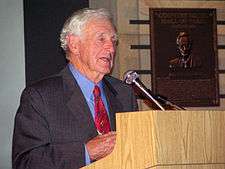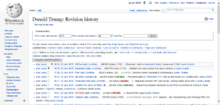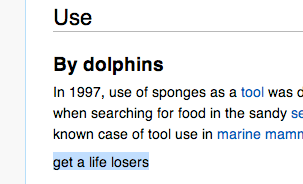Vandalism on Wikipedia
On Wikipedia, vandalism is the act of editing the project in a malicious manner that is intentionally disruptive. Vandalism includes the addition, removal, or modification of the text or other material that is either humorous, nonsensical, a hoax, or that is an offensive, humiliating, or otherwise degrading nature.
Throughout its history, Wikipedia has struggled to maintain a balance between allowing the freedom of open editing and protecting the accuracy of its information when false information can be potentially damaging to its subjects.[1] Vandalism is easy to commit on Wikipedia because anyone can edit the site,[2][3] with the exception of articles that are currently semi-protected, which means that new and unregistered users cannot edit them.
Vandalism can be committed by either guest editors or those with registered accounts; however, a semi-protected or protected page can only be edited by autoconfirmed or confirmed Wikipedia editors, or administrators, respectively.[3] Frequent targets of vandalism include articles on hot and controversial topics, famous celebrities, and current events.[4][5] In some cases, people have been falsely reported as having died. This has notably occurred to United States Senators Ted Kennedy and Robert Byrd (both of whom are now deceased), and American rapper Kanye West (who is alive).[6]
The challenge from vandalism in Wikipedia was once characterized by the Former Encyclopædia Britannica editor-in-chief Robert McHenry:[7][8] "The user who visits Wikipedia ... is rather in the position of a visitor to a public restroom. It may be obviously dirty so that he knows to exercise great care, or it may seem fairly clean, so that he may be lulled into a false sense of security. What he certainly does not know is who has used the facilities before him."
Fighting vandalism



There are various measures taken by Wikipedia to prevent or reduce the amount of vandalism. These include:
- Using Wikipedia's history functionality, which retains all prior versions of an article, restoring the article to the last version before the vandalism occurred; this is called reverting vandalism.[4] The majority of vandalism on Wikipedia is reverted quickly.[9] There are various ways in which the vandalism gets detected so it can be reverted:
- Bots: In many cases, the vandalism is automatically detected and reverted by a bot. The vandal is always warned with no human intervention.
- Recent changes patrol: Wikipedia has a special page that lists all the most recent changes. Some editors will monitor these changes for possible vandalism.[10]
- Watchlists: Any registered user can watch a page that they have created or edited or that they otherwise have an interest in. This functionality also enables users to monitor a page for vandalism.[10]
- Incidental discovery: Any reader who comes across vandalism by chance can revert it. In 2008 it was reported that the rarity of such incidental discovery indicated the efficacy of the other methods of vandalism removal.[10]
- Locking articles so only established users, or in some cases, only administrators can edit them.[4] Semi-protected articles are those that can only be edited by those with an account that is considered to be autoconfirmed – an account that is at least 4 days old with at least 10 edits, for most accounts. Fully protected articles are those that can only be edited by administrators. Protection is generally instituted after one or more editors makes a request on a special page for that purpose, and an administrator familiar with the protection guidelines chooses whether or not to fulfill this request based on the guidelines.
- Blocking and banning those who have repeatedly committed acts of vandalism from editing for a period of time or in some cases, indefinitely.[4] Vandals are not blocked as an act of punishment – the purpose of the block is simply to prevent further damage.[11]
- The "abuse filter" extension, which uses regular expressions to detect common vandalism terms.[12]
Editors are generally warned prior to being blocked. Wikipedia employs a 4-stage warning process up to a block. This includes:[13]
- The first warning assumes good faith and takes a relaxed approach to the user. (in some cases, this level can be skipped if the editor assumes the user is acting in bad faith[14]).
- The second warning does not assume any faith and is an actual warning (in some cases, this level may also be skipped).
- The third warning assumes bad faith and is the first to warn the user that continued vandalism may result in a block.
- The fourth warning is a final warning, stating that any future acts of vandalism will result in a block.
- After this, other users may place additional warnings, though only administrators can actually carry out the block.
In 2005, Wikipedia started to require those who create new articles to have a registered account in an effort to fight vandalism. This occurred after inaccurate information was added to Wikipedia in which a journalist was accused of taking part in Kennedy's assassination.[2]
Wikipedia has experimented with systems in which edits to some articles, especially those of living people, are delayed until it can be reviewed and determined that they are not vandalism, and in some cases, that a source to verify accuracy is provided. This is in an effort to prevent inaccurate and potentially damaging information about living people from appearing on the site.[15][16]

ClueBot NG
The most famous "bot" that fights vandalism is ClueBot NG. The bot was created by Wikipedia users Christopher Breneman and Cobi Carter in 2010, (succeeding the original ClueBot, NG stands for Next Generation)[17] and uses machine learning and Bayesian statistics to determine if an edit is vandalism.[18][19]
While the bot has been effective in helping keep Wikipedia clean, some claim the bot "bites" new users by not being able to apply a human brain's knowledge to the edit, and leaving impersonal templates.[20][21]
Blacklisting
The MediaWiki title blacklist extension prevents page move vandalism and creation vandalism by using regular expressions to identify bad titles. Titles on the blacklist can only be created by or moved to by administrators. Pages that are also created repeatedly can be protected to prevent vandals from recreating bad pages.
In addition to the Title Blacklist, the spam blacklist prevents external link spamming, a form of vandalism. New/unregistered users who want to add external links are required to answer a CAPTCHA.
The bad image list prevents images that are commonly used to vandalize pages from being inserted, such as images with sexual content.
The entirety of the MediaWiki namespace, the main page, and high risk templates are protected to prevent high server load and sudden interface changes.
The edit filter can also prevent vandalism by disallowing the bad edit altogether.
Notable acts of vandalism
Seigenthaler incident

In May 2005, a user edited the biographical article about John Seigenthaler, Sr. so that it contained several false and defamatory statements.[22] The inaccurate claims went unnoticed between May and September 2005, when they were discovered by Victor S. Johnson, Jr., a friend of Seigenthaler. Wikipedia content is often mirrored at sites such as Answers.com, which means that incorrect information can be replicated alongside correct information through a number of websites. Such information can develop a misleading air of authority because of its presence at such sites:[23]
Then [Seigenthaler's] son discovered that his father's hoax biography also appeared on two other sites, Reference.com and Answers.com, which took direct feeds from Wikipedia. It was out there for four months before Seigenthaler realized and got the Wikipedia entry replaced with a more reliable account. The lies remained for another three weeks on the mirror sites downstream.
Stephen Colbert
Comedian Stephen Colbert made repeated references to Wikipedia on his TV show The Colbert Report, frequently suggesting on air that his viewers vandalize selected pages. These instances include the following:
- On a 2006 episode of his show, Colbert suggested viewers vandalize the article "Elephant". This resulted in an account named "Stephencolbert" being blocked from editing, as well as many elephant-related articles being protected.[24]
- On 7 August 2012, Colbert suggested that his viewers go to pages for possible 2012 U.S. Republican vice presidential candidates, such as the Tim Pawlenty and Rob Portman articles, and edit them many times. This was in response to a Fox News hypothesis that mass editing of the Sarah Palin page the day before she was announced as John McCain's running mate could help predict who would be chosen as Mitt Romney's running mate in the 2012 election. After Colbert's request and his viewers' subsequent actions, all these articles were put under semi-protection by Wikipedia administrators, with editing restricted to established users.[25]
When Wikipedia co-founder Jimmy Wales appeared as a guest on 24 May 2007 episode of The Colbert Report, they discussed Colbert-related vandalism. Wales later said on the show that he may have to lock down the entire Spanish-language Wikipedia for a few days after Colbert commented that perhaps it should learn English.[26]
Hillsborough disaster vandalism
In April 2014, the Liverpool Echo reported that computers on an intranet used by the United Kingdom government had been used to post offensive remarks about the Hillsborough disaster on Wikipedia pages relating to the subject. The government announced that it would launch an inquiry into the reports.[27] Following the allegations, The Daily Telegraph reported that government computers appeared to have been used to vandalize a number of other articles, often adding insulting remarks to biographical articles, and in one case falsely reporting a death.[28]
Other notable acts of vandalism
- A vandal called Willy on Wheels renamed thousands of articles so that their titles ended with "on wheels".[29]
- In 2006, Rolling Stone printed a story about Halle Berry based on false information from Wikipedia, which had arisen from an act of Wikipedia vandalism.[30]
- In August 2007, local media from the Netherlands reported that several IP addresses from Nederlandse Publieke Omroep had been blocked from Wikipedia for adding "false and defamatory" information to pages.[31] A similar incident occurred with the Minister of the Interior in France in January 2016.[32]
- Professional golfer Fuzzy Zoeller sued a Miami company whose IP-based edits to the Wikipedia site included negative information about him.[33]
- In May 2012, media critic Anita Sarkeesian created a Kickstarter project, intending to raise money to make a series of videos exploring sexism in digital gaming culture.[34] The idea evoked a hostile response,[35] which included repeated vandalism of Sarkeesian's Wikipedia article with pornographic imagery, defamatory statements, and threats of sexual violence.[36] More than 12 anonymous editors contributed to the ongoing vandalism campaign before editing privileges were revoked for the page.[35]
- In November 2012, the Leveson report—published in the UK by Lord Justice Leveson—incorrectly listed a "Brett Straub" as one of the founders of The Independent newspaper. The name originated from one of the several erroneous edits by one of Straub's friends as a prank to Wikipedia by falsely including his name in several articles across the site. The name's inclusion in the report suggested that that part of the report relating to that newspaper had been cut and pasted from Wikipedia without a proper check of the sources.[37][38] The Straub issue was also humorously referenced in broadcasts of BBC entertainment current affairs TV program Have I Got News for You (and extended edition Have I Got a Bit More News for You),[39][40] with The Economist also making passing comment on the issue: "The Leveson report...Parts of it are a scissors-and-paste job culled from Wikipedia".[41]
- In April 2015, The Washington Post reported on an experiment by "Gregory Kohs, a former editor, and prominent Wikipedia critic": "Kohs wrapped up an experiment in which he inserted outlandish errors into 31 articles and tracked whether editors ever found them. After more than two months, half of his hoaxes still had not been found—and those included errors on high-profile pages, like "Mediterranean climate" and "inflammation." (By his estimate, more than 100,000 people have now seen the claim that volcanic rock produced by the human body causes inflammation pain.)"[42]

- In July 2015, Donald Trump's entire Wikipedia page was replaced with one sentence critical of him.[43][44][45]
- In August 2016, a sentence was added to Chad le Clos's Wikipedia page says that he "Died at the hands of Michael Phelps, being literally blow out of the water by the greatest American since Abraham Lincoln" after Phelps won the gold medal for 200-meter butterfly at the 2016 Summer Olympics.[46] This instance of Wikipedia vandalism attracted moderate media attention.[47]
- In October 2016, both Hillary and Bill Clinton's Wikipedia pages were vandalized and pornographic images added to their articles. This was done by a member of the Gay Nigger Association of America, an Internet trolling group.[48]
- In October 2016 New York Assembly candidate Jim Tedisco's Wikipedia page was modified to say that he had "never been part of the majority", and "is considered by many to be a total failure". Tedisco expressed dismay at the changes to his page.[49]
- The week of 29 January 2017 saw various acts of vandalism committed on Wikipedia. White House Press Secretary Sean Spicer's Wikipedia page was vandalized and his picture replaced with that of Baghdad Bob, Dana J. Boente's page description was edited to read that he was "the newest sock puppet for the Trump Administration", and Paul Ryan's picture was added to a list of invertebrates, with the edit summary stating that he was added due to his lack of a spine. These cases of vandalism attracted media attention.[50][51][52]
- On July 24, 2018, Utah senator Orrin Hatch posted humorous tweets after Google claimed that he had died on September 11, 2017.[53] The cause of the error was later revealed to be vandalism on Wikipedia inserting that as Hatch's death date.[54][55][56]
See also
References
- ↑ "Wikipedia testing new method to curb false info". CSMonitor.com. Retrieved 7 June 2012.
- 1 2 "Wikipedia tightens editorial rules after complaint – 06 December 2005". New Scientist. Retrieved 7 June 2012.
- 1 2 "Wikipedia tightens online rules". BBC News. 6 December 2005.
- 1 2 3 4 Kleeman, Jenny (2 April 2007). "Wikipedia fights vandalism". New Zealand Herald.
- ↑ Martin, Lorna (18 June 2006). "Wikipedia fights off cyber vandals". The Guardian. London.
- ↑ "Vandals prompt Wikipedia to ponder editing changes". ABC News. 28 January 2009. Retrieved 26 November 2011.
- ↑ "Caslon Analytics: wiki and wikipedia". Caslon Analytics. Archived from the original on 22 July 2012. Retrieved 13 July 2010.
- ↑ Robert McHenry (15 November 2004). "The Faith-Based Encyclopedia". TCS Daily. Archived from the original on 19 July 2006. Retrieved 10 September 2009.
- ↑ Hicks, Jesse. "This machine kills trolls". The Verge. Retrieved 18 February 2014.
- 1 2 3 Broughton, John (2008). Wikipedia: the missing manual. p. 122. ISBN 0-596-51516-2.
- ↑ Broughton, John (2008). Wikipedia: the missing manual. p. 134. ISBN 0-596-51516-2.
- ↑ See Wikipedia:Edit filter
- ↑ Broughton, John (2008). Wikipedia: the missing manual. pp. 130–31. ISBN 0-596-51516-2.
- ↑ See Wikipedia:WikiProject User warnings/Usage and layout § Levels
- ↑ "Wikipedia Tests Approval System to Reduce Page Vandalism". Maximum PC. 19 July 2008. Retrieved 7 June 2012.
- ↑ "Wikipedia plans to enforce new editing policy to thwart vandals – eBrandz Search Marketing & Technology News". News.ebrandz.com. 27 August 2009. Archived from the original on 21 June 2012. Retrieved 7 June 2012.
- ↑ "This machine kills trolls". The Verge. 18 February 2014. Retrieved 11 April 2017.
- ↑ Nasaw, Daniel (25 July 2012). "Meet the 'bots' that edit Wikipedia". BBC News.
- ↑ Raja, Sumit. "Little about the bot that runs Wikipedia, ClueBot NG". digitfreak.com. Retrieved 11 April 2017.
- ↑ "How does Wikipedia's content review bot ClueBot NG review Wikipedia pages and validate their facts? – Quora". www.quora.com. Retrieved 11 April 2017.
- ↑ "The Bots Who Edit Wikipedia (And The Humans Who Made Them)". MakeUseOf. Retrieved 11 April 2017.
- ↑ John Seigenthaler (29 November 2005). "A false Wikipedia "biography"". USA Today.
- ↑ "Mistakes and hoaxes on-line". Australian Broadcasting Corporation. 15 April 2006. Retrieved 28 April 2007.
- ↑ "Did Colbert hack Wikipedia? – VIDEO". Tvsquad.com. Archived from the original on 19 January 2011. Retrieved 7 June 2012.
- ↑ "Stephen Colbert's Wikipedia Vice Presidential Scheme Short Circuited". The Hollywood Reporter. 8 August 2012. Retrieved 8 August 2012.
- ↑ "Jimmy Wales". Comedy Central. 24 May 2007. Archived from the original on 10 May 2008. Retrieved 2 September 2008.
- ↑ "Hillsborough Wikipedia posts were 'sickening', Cabinet Office says". BBC News. BBC. 25 April 2014. Retrieved 25 April 2014.
- ↑ Duggan, Oliver (27 April 2014). "Des Lynam 'killed by a giant snowball' and other embarrassing Wikipedia edits from Whitehall computers". The Daily Telegraph. Telegraph Media Group. Retrieved 4 May 2014.
- ↑ Dee, Jonathan (1 July 2007). "Wikipedia - Computers and the Internet - Encyclopedias - News and News Media". New York Times. Retrieved 26 May 2018.
- ↑ "Rolling Stone prints story based on Wikipedia vandalism – Wikinews, the free news source". En.wikinews.org. Retrieved 7 June 2012.
- ↑ "Wikipedia blokkeert medewerkers publieke omroep". De Volkskrant (in Dutch). 30 August 2007. Retrieved 3 April 2017.
- ↑ Tual, Morgane (13 January 2016). "Une adresse IP du ministère de l'intérieur bloquée sur Wikipédia pour « vandalisme »". LeMonde.fr (in French). Retrieved 3 April 2017.
- ↑ Cheung, Humphrey (26 February 2007). "Pro golfer sues over Wikipedia vandalism". Tom's Hardware.
- ↑ Carlen Lavigne (24 January 2013). Cyberpunk Women, Feminism and Science Fiction: A Critical Study. McFarland. p. 184. ISBN 978-0-7864-6653-5. Retrieved 20 April 2013.
- 1 2 Helen Lewis (12 June 2012). "Dear The Internet, This Is Why You Can't Have Anything Nice". New Statesman. Retrieved 20 April 2013.
- ↑ Andrea Weckerle (13 February 2013). Civility in the Digital Age: How Companies and People Can Triumph over Haters, Trolls, Bullies and Other Jerks. Que Publishing. p. 33. ISBN 978-0-13-313498-8. Retrieved 20 April 2013.
- ↑ Allen, Nick (5 December 2012). "Wikipedia, the 25-year–old student and the prank that fooled Leveson". The Daily Telegraph. Telegraph Media Group. Retrieved 8 December 2012.
- ↑ Andy McSmith (30 November 2012). "Leveson's Wikipedia moment: how internet 'research' on The Independent's history left him red-faced". The Independent.
- ↑ "Have I Got News for You (series 44, episode 8) TV programme". BBC. 7 December 2012. Retrieved 12 December 2012.
- ↑ "Have I Got News for You: Series 44, Episode 8 (Leveson clip)". BBC. 7 December 2012. Retrieved 12 December 2012.
- ↑ "Hacked to pieces". The Economist. 8 December 2012. Retrieved 8 December 2012.
- ↑ Caitlin Dewey (15 April 2015). "The story behind Jar'Edo Wens, the longest-running hoax in Wikipedia history". The Washington Post. Retrieved 19 October 2016.
- ↑ Ben Popper (22 July 2015). "Someone just deleted Donald Trump's entire Wikipedia page". The Verge (Vox Media).
- ↑ "All The Content On Donald Trump's Wikipedia Page Was Just Deleted". TPM.
- ↑ Andrea Peterson (22 July 2015). "Donald Trump’s Wikipedia page was deleted today. Twice.". Washington Post.
- ↑ "Somebody trolled Chad Le Clos with the greatest Wikipedia page edit ever". 10 August 2016. Retrieved 12 August 2016.
- ↑ "Chad le Clos' Wikipedia Page Edited to Say Phelps Killed Him". Retrieved 12 August 2016.
- ↑ O'Connor, Brendan (October 13, 2016). "Internet Trolls Vandalize Hillary and Bill Clinton's Wikipedia Pages in Extremely NSFW Way". Retrieved October 13, 2016.
- ↑ "Assemblyman Tedisco's Wikipedia vandalized".
- ↑ Kircher, Madison Malone. "Wikipedia Edits Are the Only Joy in These Fraught Political Times". Select All. Retrieved 2 February 2017.
- ↑ "Wikipedia briefly listed politicians and other invertebrates". Houston Chronicle. Retrieved 2 February 2017.
- ↑ "From the strange specimen of Paul Ryan to Uber's big dropoff – The Boston Globe". BostonGlobe.com. Retrieved 2 February 2017.
- ↑ Ehrlich, Jamie (July 24, 2018). "GOP senator says he is alive amid Google searches suggesting he is dead". CNN. Retrieved September 11, 2018.
- ↑ Horton, Alex (July 24, 2018). "Is Orrin Hatch dead? Let me Google that for you". Washington Post. Retrieved September 11, 2018.
- ↑ All Things Considered (July 24, 2018), from National Public Radio.
- ↑ The actual edit was here: Wikipedia contributors. "Orrin Hatch: Difference between revisions". Wikipedia. Wikimedia Foundation. Retrieved 24 July 2018.

